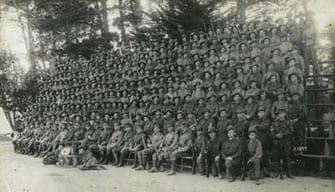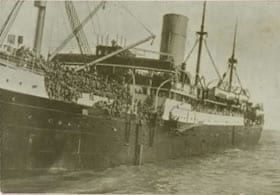The Australian Imperial Force (AIF) took part in some of the bloodiest battles of World War 1 and they were used as “Shock” troops by the British Commanders as they got the “job done”.
In July 1916 Australian infantry in the trenches and the battle for Fromelles, suffered 5,533 casualties in 24 hours. By the end of the year about 40,000 Australians had been killed or wounded on the Western Front. In 1917 a further 76,836 Australians became casualties in battles, including Bullecourt, Messines, and the four-month campaign around Ypres, known as the battle of Passchendaele.
Unlike their counterparts in France and Belgium, the Australians in the Middle East fought a mobile war against the Ottoman Empire in conditions completely different from the mud and stagnation of the Western Front. The light horsemen and their mounts had to survive extreme heat, harsh terrain, and water shortages. Casualties in this campaign were comparatively light, with 1,394 Australians killed or wounded in three years of war.
The campaign began in 1916 with Australian troops participating in the defense of the Suez Canal and the allied re-conquest of the Sinai peninsular. In the following year Australian and other allied troops advanced into Palestine and captured Gaza and Jerusalem; by 1918 they had occupied Lebanon and Syria. On 30 October 1918 Turkey sued for peace.
Australians also served at sea in the Royal Australian Navy (RAN) and in the air with the newly formed Royal Flying Corps (RFC). The Great War was the first armed conflict in which aircraft were used; about 3,000 Australian airmen served in the Middle East and France with the Australian Flying Corps.
Australian women volunteered for service in auxiliary roles, as cooks, nurses, drivers, interpreters, munitions workers, and skilled farm workers. Australian nurses served in Egypt, France, Greece, and India, often in trying conditions or close to the front, where they were exposed to shelling and aerial bombardment.
The effect of the war was also felt at home. Families and communities grieved following the loss of so many men, and women increasingly assumed the physical and financial burden of caring for families. When the war ended, thousands of ex-servicemen, many disabled with physical or emotional wounds, had to be re-integrated into a society keen to consign the war to the past and resume normal life.
The GREAT WAR ended on the 11th hour of the 11th day of the 11th Month in 1918 when an Armistice Agreement was signed and the guns fell silent. The official DECLARATION OF SURRENDER was signed on the 28th June 1919 and became known as “The Treaty of Versailles”.
World War I introduced new words and technologies that would shape the future of the World forever. The word Tank, Airplane and Submarine (U-Boat) would become household names.
The aftermath of World War I also marked the practical end of monarchy on the European continent and of colonialism throughout the rest of the world. Most European nations began to rely increasingly upon parliamentary systems of government, and socialism gained increasing popularity.
The brutality of the conflict and the enormous loss of human life inspired a renewed determination among nations to rely upon diplomacy to resolve conflicts in the future.
This resolve directly inspired the birth of the “League of Nations”.
Sixty-five Victoria Crosses were awarded to Australians during World War 1.

